I thought I'd share this for anyone interested. I am building open baffle subwoofers and I did some testing to find the better design. I was considering Ripole, SLOB, and H-frame. I figured that ripole and SLOB are both similar in that they constrict the front-firing side of the woofer so I built a ripole-like box with an adjustable gap and one 12" woofer to test it:

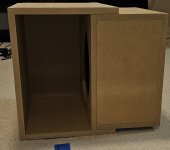
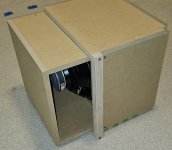
The cover slides left and right and fits pretty firmly for a decent seal. The back side of the box has a fixed opening of 13.5" tall x 6" wide and I tested the front various widths, all with fixed height of 14.75". Widths: 8.5", 6", 4", 2", 1". I tested with the enclosure and mic on the floor near the middle of my living room. I tested at 3ft and at 6ft mic distances, but turns out 6ft doesn't really matter because 3ft shows plenty. I also measured the back side at 3ft but that didn't show anything interesting either.

After doing this test I realized the ~90hz and ~110hz dips were because I tested with the mic on the wrong side of the room. When I 'flipped' the mic side those disappeared, all looked smooth like the green nude line. So ignore those and only compare the differences rather than absolutes. Here's a couple more for comparison:

I already had 8" boards attached so that's why I tested the 15x15x8 'sealed' box (open side face down into carpet). I also tested a 2x4 wide-face across center of the 15" square OB and it made very little difference. I also 3d-printed a conical insert that I tape to some wood to make a ring-gap but the test was even worse down low than the 2x4. I tried a couple depths with that and none were beneficial.
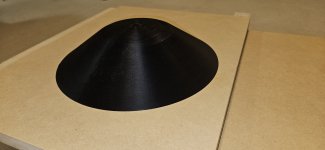
So basically the largest 'ripole' gap (which is the largest slot if it were a SLOB) performed the best. This isn't what I expected, I thought something like a 2" gap would be better, but I was wrong.
I'm going with the H-frame because it looks the best overall and it has no weirdness after 300hz, less coloration. The ripole-style box doesn't really save me space anyway because for this build I want them narrow and tall. My goal is to get 20hz-40hz as high as possible with 12" open baffle while fitting reasonably well in my space.
I know this test isn't exactly the same as ripole because it is just one-sided, but theoretically if this 1 woofer was playing twice as loud as a ripole pair would then the character of the output would be about the same, excluding the distortion difference from the offset & excursion distance. This test was just to see how the restriction of the front in this style would perform.
My conclusion: don't restrict woofers.



The cover slides left and right and fits pretty firmly for a decent seal. The back side of the box has a fixed opening of 13.5" tall x 6" wide and I tested the front various widths, all with fixed height of 14.75". Widths: 8.5", 6", 4", 2", 1". I tested with the enclosure and mic on the floor near the middle of my living room. I tested at 3ft and at 6ft mic distances, but turns out 6ft doesn't really matter because 3ft shows plenty. I also measured the back side at 3ft but that didn't show anything interesting either.
After doing this test I realized the ~90hz and ~110hz dips were because I tested with the mic on the wrong side of the room. When I 'flipped' the mic side those disappeared, all looked smooth like the green nude line. So ignore those and only compare the differences rather than absolutes. Here's a couple more for comparison:
I already had 8" boards attached so that's why I tested the 15x15x8 'sealed' box (open side face down into carpet). I also tested a 2x4 wide-face across center of the 15" square OB and it made very little difference. I also 3d-printed a conical insert that I tape to some wood to make a ring-gap but the test was even worse down low than the 2x4. I tried a couple depths with that and none were beneficial.

So basically the largest 'ripole' gap (which is the largest slot if it were a SLOB) performed the best. This isn't what I expected, I thought something like a 2" gap would be better, but I was wrong.
I'm going with the H-frame because it looks the best overall and it has no weirdness after 300hz, less coloration. The ripole-style box doesn't really save me space anyway because for this build I want them narrow and tall. My goal is to get 20hz-40hz as high as possible with 12" open baffle while fitting reasonably well in my space.
I know this test isn't exactly the same as ripole because it is just one-sided, but theoretically if this 1 woofer was playing twice as loud as a ripole pair would then the character of the output would be about the same, excluding the distortion difference from the offset & excursion distance. This test was just to see how the restriction of the front in this style would perform.
My conclusion: don't restrict woofers.
Last edited:
Oh, I also tested the back side to see if the asymmetrical opening sizes caused any cardioid-ish response, but I can't see any in the graphs. The enclosure makes the FR drop fast after ~250hz which is about where I was expecting the cardioid effect to begin.
One advantage of SLOB is ability to use opposed drivers nested magnet-to-cone orientation to negate suspension induced harmonic distortion. You can do a SLOB with an H or U baffle as I did with XSD. The harmonic distortion levels were extremely low -55dB (approaching $$ Purifi woofer territory using inexpensive $10 drivers).
https://www.diyaudio.com/community/threads/the-xsd-speaker.385717/
Look at distortion levels (woofer crossed at 470Hz):

https://www.diyaudio.com/community/threads/the-xsd-speaker.385717/
Look at distortion levels (woofer crossed at 470Hz):
Some tips for you when designing a true subwoofer system…..at 80hz and below most rooms are purely modal in the response and the ONLY function of a ‘sub’ woofer is to excite those modes as evenly and effectively as possible. Understanding the above reveals one fact…….one transducer placed in one space can never accomplish this. All open baffle systems can do below 80hz is reduce the randomization and give the listener as much direct sound as possible, simulating monitoring or listening in the near field…….its an awkward thing to listen to with an unintended benefit……..some additional midbass punch or slam that is direct and somewhat relieved of time smearing of modal response in the 100-300hz region.
So consider the above, your testing and the extensive testing of Linkwitz over quite a few decades expose the underlying truth……OB is only useful and one might add ‘the most effective’ solution for midbass….from 80hz and up. OB users that share their experiences most often tout the immediacy and time correct response of the midbass region. But from 80hz all is lost. In other words, below 80hz……excite as many modes as you possibly can if you want meaningful and flat response. This can be accomplished with as few as three small sealed subwoofers and somewhat equandestant placement. Four is better with one of the woofers 180 out of phase with the others. Where that 4th ‘sacrificial’ sub is placed will take some experimenting as it’s function isn’t bass production but in room smoothing…..like an acoustic treatment only more effective as it’s an active treatment that works with direct response instead of passive that can only treat a small range of modal response.
Keep your H frame…..a pair will likely sound great from 800-300hz or so…..better than any box can do…..but below that,………work with the room……..not against it. Best of luck!
So consider the above, your testing and the extensive testing of Linkwitz over quite a few decades expose the underlying truth……OB is only useful and one might add ‘the most effective’ solution for midbass….from 80hz and up. OB users that share their experiences most often tout the immediacy and time correct response of the midbass region. But from 80hz all is lost. In other words, below 80hz……excite as many modes as you possibly can if you want meaningful and flat response. This can be accomplished with as few as three small sealed subwoofers and somewhat equandestant placement. Four is better with one of the woofers 180 out of phase with the others. Where that 4th ‘sacrificial’ sub is placed will take some experimenting as it’s function isn’t bass production but in room smoothing…..like an acoustic treatment only more effective as it’s an active treatment that works with direct response instead of passive that can only treat a small range of modal response.
Keep your H frame…..a pair will likely sound great from 800-300hz or so…..better than any box can do…..but below that,………work with the room……..not against it. Best of luck!
Last edited:
My XSD dipole SLOB went down to 42Hz (-3dB). The 30Hz room mode peak present with conventional speakers was not observed with the XSD. So the dipole helps reduce effect of the room mode from what I experienced in my room. The bass is very satisfying - quite powerful and visceral without the room modes.
Yes…..with 4 $500 woofers, dedicated channels of amplification, DSP and that’s with room gain.…..we spec f3 anechoic which is more likely in the 40’s.……….not a practical solution in myHi @mayhem13ssz
But didn't Linkwitz himself go as low as 30Hz with the LX521.4?
So according to you, there is no practical way of getting decent bass (lower than 80Hz) with dipole speakers?
Thanks!
Erik
What I saw in my tests of a single woofer did not look like the FR was driven by room modal interaction. I do expect to get all the way down to 20hz with 4x $35 12" OB woofers, based on my test so far. I was prepared to be disappointed based on everything I've read, expecting just 40hz or maybe down to 30hz, but this test data shows 20hz is totally achievable with 4 of these subs in an OB H-frame.
Yes, I will use DSP to tune the response. I'll have every driver on its own channel with its own amp and with REW and CamillaDSP I can tune them nicely.
At the amp volume level I've been testing with I am able to get 70dB from sub, mid, and tweeter for the full 20-20k. Extra subs are needed because I generally like the LF FR to rise significantly, and more woofers equals less excursion which produces less distortion.
Yes, I will use DSP to tune the response. I'll have every driver on its own channel with its own amp and with REW and CamillaDSP I can tune them nicely.
At the amp volume level I've been testing with I am able to get 70dB from sub, mid, and tweeter for the full 20-20k. Extra subs are needed because I generally like the LF FR to rise significantly, and more woofers equals less excursion which produces less distortion.
Would you endorse dedicated SLOB subs? That is, 80Hz and below? (I'm picturing larger drivers with DSP)My XSD dipole SLOB went down to 42Hz
I’m working with four 12’s in a SLOB for a few months now….ive only built 1 and I’m experimenting with the slot volume and just listening. My space is 14x18 feet. I’m f6 around 45hz at the LP at 86db where my laser shows my 12s are just below Xmax at 7mm with a 30hz tone burst. With a second unit, I would expect to get an increase in the overall level but nothing deeper. These do sound excellent with midbass……very tactile and you hear the drivers instead of the modes or lack there of. But even though in room measurements show decent output from 90 down to 50hz, it’s anemic……nothing compared to when the sealed subs are on which is quite visceral……..the OB drivers simply cannot pressurize the room. I’m fortunate to have an extensive library of kick drum samples including some 26” and I can tell you, the SLOB on its own doesn’t cut it……not even close at 92db where with the subs you can feel the kick…..with the OB, you get the impact…..but no thud.……..it’s cleaner………..but not real…..not like our Ludwig or Gretsch kicks In our drum room which is nearly the same size.What I saw in my tests of a single woofer did not look like the FR was driven by room modal interaction. I do expect to get all the way down to 20hz with 4x $35 12" OB woofers, based on my test so far. I was prepared to be disappointed based on everything I've read, expecting just 40hz or maybe down to 30hz, but this test data shows 20hz is totally achievable with 4 of these subs in an OB H-frame.
Yes, I will use DSP to tune the response. I'll have every driver on its own channel with its own amp and with REW and CamillaDSP I can tune them nicely.
At the amp volume level I've been testing with I am able to get 70dB from sub, mid, and tweeter for the full 20-20k. Extra subs are needed because I generally like the LF FR to rise significantly, and more woofers equals less excursion which produces less distortion.
Last edited:
Hi Gents,
Advice ps, starting a build soon, have aquired 16 pcs 8 inch woofers, spec states 87db, main driver are Seas Fa22.
My question is should I just use 6 woofers per side or 8, looking into XO at 250hz. If we're using 3 pairs it should produce a
theoritical 96 db, is this sufficient ? Am aware of the cancellation but there's also an added boost from room response hence.
Many thanks
Advice ps, starting a build soon, have aquired 16 pcs 8 inch woofers, spec states 87db, main driver are Seas Fa22.
My question is should I just use 6 woofers per side or 8, looking into XO at 250hz. If we're using 3 pairs it should produce a
theoritical 96 db, is this sufficient ? Am aware of the cancellation but there's also an added boost from room response hence.
Many thanks
It depends on the sensitivity of the rest of the range. If you have weak low-mids then you don't need a lot of sub. The 2x12" I used on each side are more than enough for my setup. I have an 8" OB mid woofer and a 3" planar on top. The 8" @ 250hz is the lowest SPL in the whole system so I had to bring everything down to match that.
At this point I'm not sure if OB subs was really a better choice over sealed or not. In REW the OB measures pretty well but it's true that there is less thump when listening because of the missing compression of the room. If it was easy and if I hadn't spent so much time on this already, or if I was starting over, I'd probably start with a sealed 15" for under 100hz, and OB above that.

I haven't done phase alignment yet but I'm using brickwall XO from rePhase and it seems to work quite well with enough taps. Thinking about upgrading my HTPC so I can use plenty of taps at 192khz instead of 48khz.
At this point I'm not sure if OB subs was really a better choice over sealed or not. In REW the OB measures pretty well but it's true that there is less thump when listening because of the missing compression of the room. If it was easy and if I hadn't spent so much time on this already, or if I was starting over, I'd probably start with a sealed 15" for under 100hz, and OB above that.
I haven't done phase alignment yet but I'm using brickwall XO from rePhase and it seems to work quite well with enough taps. Thinking about upgrading my HTPC so I can use plenty of taps at 192khz instead of 48khz.
Last edited:
@sumotan are you trying to use the 8" under 250hz or over? I use 8" from 250hz to 1khz. The SPL drops pretty fast under 250hz with OB 8".
This is what I get from a single 8" in this baffle, and the baffle helps quite a lot with the LF:

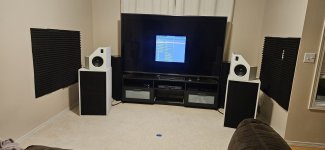
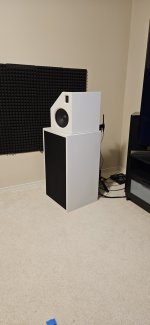
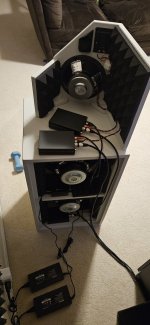
This is what I get from a single 8" in this baffle, and the baffle helps quite a lot with the LF:



Hi Sapphire,
No Im looking at using either 3 or 4 pairs of woofer per speaker from 250/300hz down just for bass augmentation.
250/300hz up will be handled by Seas FR driver. Following slop design as per XKR's design.
Many thanks
No Im looking at using either 3 or 4 pairs of woofer per speaker from 250/300hz down just for bass augmentation.
250/300hz up will be handled by Seas FR driver. Following slop design as per XKR's design.
Many thanks
I agree that OB subwoofers is absolute fantastic and that it has some limitation when the wavelength of the low notes is exceeding the room length. So when you say that 80Hz is the lowest frequency a dipole subwoofer is preferred to operate you also has to state that it implies for a 4,2 meter long room.Some tips for you when designing a true subwoofer system…..at 80hz and below most rooms are purely modal in the response and the ONLY function of a ‘sub’ woofer is to excite those modes as evenly and effectively as possible. Understanding the above reveals one fact…….one transducer placed in one space can never accomplish this. All open baffle systems can do below 80hz is reduce the randomization and give the listener as much direct sound as possible, simulating monitoring or listening in the near field…….its an awkward thing to listen to with an unintended benefit……..some additional midbass punch or slam that is direct and somewhat relieved of time smearing of modal response in the 100-300hz region.
So consider the above, your testing and the extensive testing of Linkwitz over quite a few decades expose the underlying truth……OB is only useful and one might add ‘the most effective’ solution for midbass….from 80hz and up. OB users that share their experiences most often tout the immediacy and time correct response of the midbass region. But from 80hz all is lost. In other words, below 80hz……excite as many modes as you possibly can if you want meaningful and flat response. This can be accomplished with as few as three small sealed subwoofers and somewhat equandestant placement. Four is better with one of the woofers 180 out of phase with the others. Where that 4th ‘sacrificial’ sub is placed will take some experimenting as it’s function isn’t bass production but in room smoothing…..like an acoustic treatment only more effective as it’s an active treatment that works with direct response instead of passive that can only treat a small range of modal response.
Keep your H frame…..a pair will likely sound great from 800-300hz or so…..better than any box can do…..but below that,………work with the room……..not against it. Best of luck!
My room is 10 meter long and I let the dipole woofers play down to 27Hz and between 15Hz and 27Hz I go IB with 4x15" woofers just to get that pressure change in the room playing some weird records. Or watching a movie.
I have had similar results. If you want to cross high then an H-frame or flat baffle is your best option, folded dipoles are just worse in that setup.
As I see it there are 2 main benefits of a folded dipole sub like the W-frame or ripole:
Those are nice benefits though so in my speakers I keep going back to them even with the disadvantages of slightly more distortion and having to cross far lower 😆
As I see it there are 2 main benefits of a folded dipole sub like the W-frame or ripole:
- Can be more compact than a H-frame
- Can easily be configured in a force cancelling setup, which an H-frame cannot do
Those are nice benefits though so in my speakers I keep going back to them even with the disadvantages of slightly more distortion and having to cross far lower 😆
Last edited:
H frame and slot loading is causing a resonance. It is also true that force cancellation is a good idea if you not can afford really thick strong heavy materials.
A good compromise is to make the baffle more w shape. So you will have 80% force cancellation instead of 100%. Also a slot that is triangular and do not create that sharp high Q resonance. And it will be slightly more compact.
A good compromise is to make the baffle more w shape. So you will have 80% force cancellation instead of 100%. Also a slot that is triangular and do not create that sharp high Q resonance. And it will be slightly more compact.
- Home
- Loudspeakers
- Subwoofers
- H-frame tested better than Ripole / SLOB style